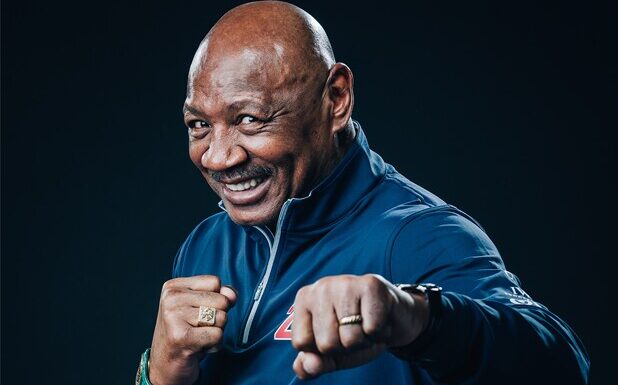Away from the ring, middleweight legend endeared and entranced those who met him with honesty and simplicity
‘Marvelous’ Marvin Hagler, the former undisputed middleweight world champion, who died on Saturday at the age of 66, was a very special human being.
Brutal and brooding, he remains one of the most durable fighters ever to step inside a ring, the New Jersey native testing himself in a dynamic era involving three other legends of the sport, all of whom he fought: Thomas Hearns, Roberto Duran, and Sugar Ray Leonard.
From the eight minutes of mayhem and violence in his defeat of Hearns – one of the greatest brawls of all time – to the victory over Duran, and the triumphs over British opponents Alan Minter and Tony Sibson, Hagler has remained in the minds of many fans as one of the greatest and most adored of boxers.
Uncompromising, simplistic even, the image of Hagler and his hairless cranium summons up the era of the quartet known as ‘The Four Kings’.
Though he was defeated on points by Leonard, Hagler always disputed the decision. As did many others. Of all the greatest middleweights in history, Hagler sits alongside Sugar Ray Robinson, Carlos Monzon and Harry Greb in the division’s top four.
Southpaw in stance, and a brooding menace, he was technically brilliant, heavy-handed, and arguably had one of the greatest chins ever seen.
Hagler was knocked down just once in 67 fights – and even that was disputed – during his 14-year professional career. He claimed victory in 62 of those bouts, with 52 wins by knockout, while he drew two and lost three times. At his peak, Hagler made 12 middleweight title defences and developed a huge fanbase.
In 1982, irked that television announcers were not referring to him by his ring sobriquet ‘Marvelous’, he changed his legal name to ‘Marvelous Marvin Hagler’. But away from his ringcraft, Hagler also had a side to his personality that both endeared and entranced those who met him due to his honesty and simplicity.
Bob Arum, the 89-year-old Las Vegas based promoter who oversaw Hagler’s fights in his heyday, said the great fighter was meticulous with his money.
“Hagler never spent five cents in a casino. All the time I knew him he never bought me a meal,” Arum explained in a recent interview with Telegraph Sport. “Every dollar he made he put in the bank and saved so that when he retired he had all the money he would need for the rest of his life.”
Indeed, Hagler never needed to fight Leonard, according to Arum. But for the fight with Leonard, Hagler earned $18 million.
The 12-round championship fight pitched destructive southpaw Hagler, a blue-collar favourite, against pretty boy Sugar Ray, a former Olympic champion, a media darling who had been retired for three years and was stepping up two modern weight divisions against the menacing figure almost a stone heavier.
Hagler, who had grown up tough on the streets of Newark as a kid until his family moved him to Brockton in Massachusetts after the tenement where he lived burnt down in the 1967 riots, was a 7-1 favourite.
It was judged a horrific mismatch, yet Leonard used his ring smarts and his speed and footwork to keep Hagler at bay. Irked at the result, and Leonard’s tactics, Hagler retired, saddled up and left for Italy, and a career in spaghetti Westerns. With fistfuls of dollars in the bank.
But the accolades were already there for Hagler: he was chosen as the Fighter of the Decade for the 1980s by Boxing Illustrated magazine; he won the Ring Magazine Fighter of the Year award twice; and he was inducted into the International Boxing Hall of Fame in 1993.
Hagler had strong views on the sport, long after his retirement. In 2019, he said he wanted boxing to return to “one champion per division”, and told Telegraph Sport in 2013 that drugs cheats should be banned for life.
“In my day it was all about what you did with your own capability, and not with some kind of enhancement,” he said. “In my time we had never heard of drugs like there are now. Your life is on the line every time you step between those ropes. Boxing is a dangerous sport and should be made as safe as possible.”
In December 2007, 20 years after his blockbuster with Leonard, I found myself in the streets of Casablanca with Hagler, and double Olympic champion Daley Thompson on a visit to a project run by Nawal El Moutawakel, the first Muslim, Arab and African woman to win a gold medal at the Olympic Games – in Los Angeles in 1984. El Moutawakel was then Minister for Youth and Sports in that country.
We took part in the Courir pour La Vie project, a pilot scheme at Imam Mouslim High School, in Ben Abid, a dusty roadside village 20 miles outside Casablanca.
The programme promoted sports among teenage girls living in rural locations, aiming to influence changes from the traditional pattern of leaving school in their mid-teens and later entering arranged marriages.
We all took part in a match against the girls, who played fast, aggressive, basketball. Parents, who had brought lunch for the visitors, clapped and cheered. A local zouk band turned up and played their instruments. The mood intensified as Hagler and Thompson joined the players on court. It got rough.
When Hagler took a break on the sidelines, he turned to me, showing the scratches on his muscular forearms. “Look at my arms. Those girls mauled me like tigers out there,” he said with a grin, his eyes wide and alive.
“They are fantastic. So committed. No man ever did that to me.” It is a moment with the great man which will last forever.
